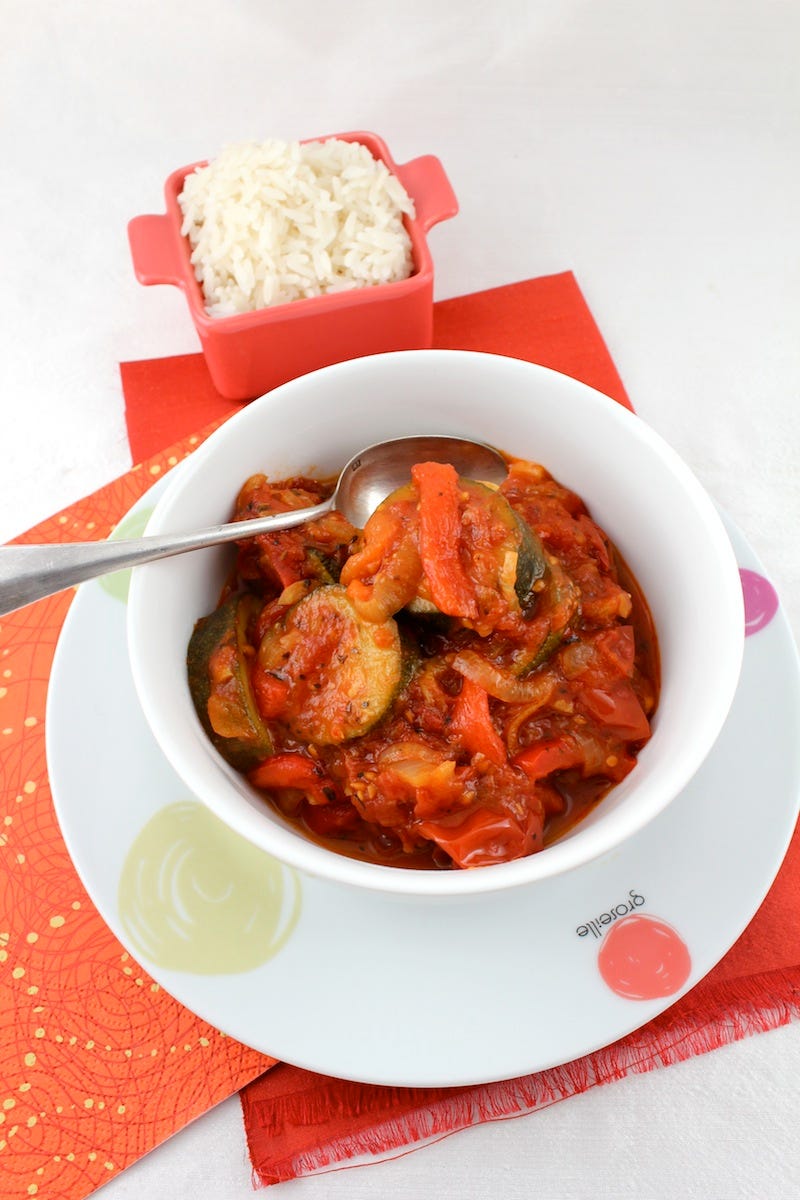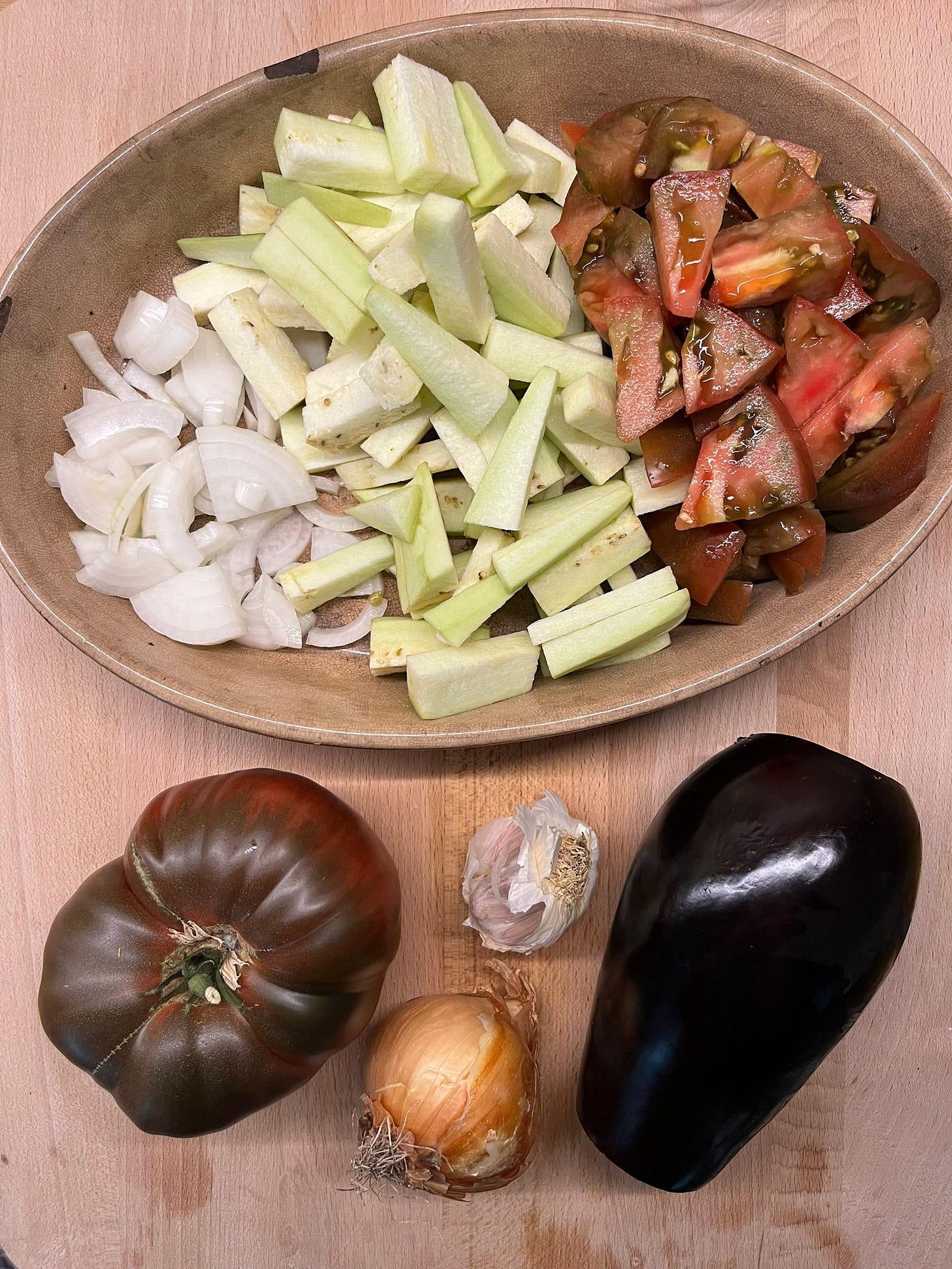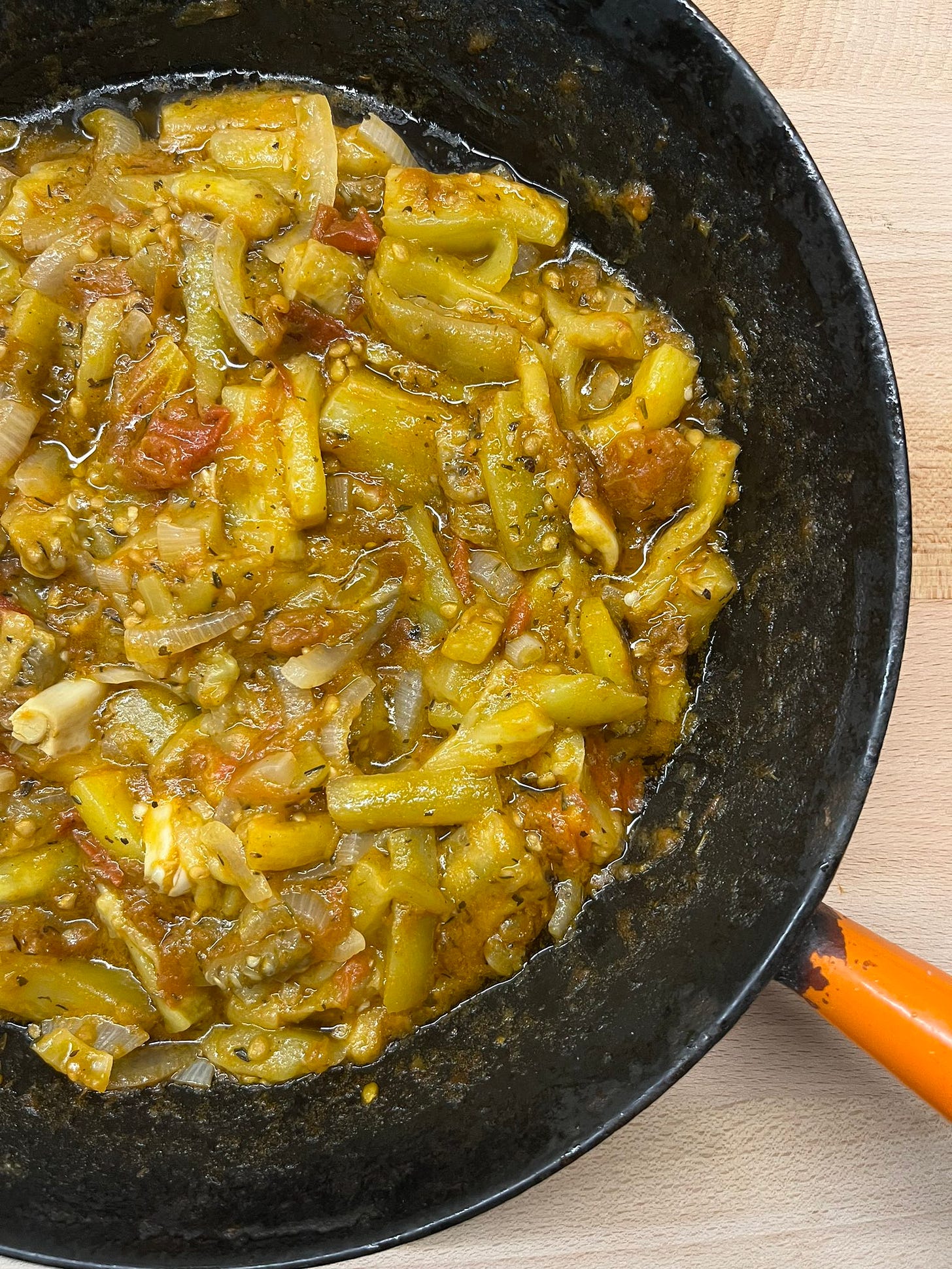Ratatouille
Bohémienne
In great quantity, madame. In great quantity. - Curnonsky
I was racking my brain to come up with a traditional savory French dish that was as ideal for summer as the salade niçoise or a tomato tart but nothing was coming. Until my discussion with Nathalie as we stood in the tiny hotel kitchen waiting for the first clients to show up for breakfast. “Ratatouille,” she said. Why of course! How could I possibly have overlooked ratatouille? Ratatouille is a classic summer dish, a specialty of Provence, using the freshest vegetables straight from the garden: eggplant, tomatoes, zucchini, onions, bell peppers, garlic, and handfuls of fresh herbs. It’s staple picnic fare and can be found on French lunch and dinner tables around the country as a side dish or main course.
I even made ratatouille for my July wedding.
Little did I imagine that there would be a story behind it. And what a story.
While many argue that the word ratatouille comes from the Occitan ratatolha or ratatoulho, according to Le Robert, considered the authoritative single-volume dictionary of the French language, the word ratatouille “was formed on the verb touiller - to stir or toss - around which was created an abounding set of expressive verbs in various regional dialects, sometimes with reinforcement syllables”, in this case rata- possibly from the word ratatiner - to shrink or shrivel up. The word first appeared in the mid- to late- 18th century and disparagingly referred to a “foul” ragoût or stew of bad quality, often made of table scraps thrown together with whatever meat was available and watered down in long cooking. So stirring and mashing ingredients together until they shriveled up and shrunk: rata-touille.
A century later, a ratatouille still referred to a “mélange douteux, suspect” - a dubious, questionable mix. It appeared for the first time not in a cookbook but in the Journal des sciences militaires des armées de terre et de mer - The Journal of Military Science of the Land and Sea Forces - in 1831 which described "a dish of watered down, overcooked vegetables, among which float here and there some emaciated veal ribs or bad mutton" consumed by the military, farmers, as well as in prisons, because it was easy, fast, and probably cheap to cook.
In 1847, la ratatouille (ratatoulha/ratatouyo/ratatouia) is defined in the Dictionnaire Provençal-Français by Simon Jude Honnorat, medical doctor, as “une soupe pour les rats” and “un mauvais ragoût” - a soup for rats and a bad stew. He calls it a hodgepodge or a mishmash made up of reheated leftovers, a ragoût made with various meats, maybe even with animal spleens. The Vocabulaire du Bas Langage Rémois, the dialect from the Marne region around the Champagne city of Reims, (“the fruit of 25 years of research”) was much kinder to the ratatouille in its 1845 edition calling it a “fricassee of meat and vegetables”.
By this time (the mid-19th century), ratatouille seems to have been a rather common reference in popular songs and ballads, apparently even more so in the north of France; the word ratatouille appears to have continued to devolve into a derogatory term used specifically to describe a type of stew served to the military or one made from table scraps and eaten in bad dining establishments (Dictionnaire provençal-français by Joseph-Toussaint, 1839.)
An 1841 song The Philosophical Ragpicker, claims that the fricot - a dish of potatoes, onions, and meat, served in cabarets, was better than the filthy ratatouille served by a very high and powerful lord. Enfants de l’Alouette, a song in the dialect of Roubaix in the north of France written in 1857, and The Small Hardships of an Old Weaver of 1865, refer to the ratatouille being cooked in their poor, miserable homes by a drunken wife or a shoeless niece. An 1877 song has ratatouille being served up in the taverns in Chalon… alongside cat stew, mutton ragoût, and blood sausage. Louis Longret wrote quite a number of “new songs in the Lille dialect” in the 1870s; his use of the word ratatouille is descriptive: “the affair has gotten murkier than ratatouille” (L'amusmin de Saint- Sauveur) and in another his military man uses the word to describe the catastrophic ruins of a city after a bombing during the Franco-Prussian War of 1870 “Dieu! que l’ ratatouille!” (Un Mobilisé).
For half a century, a ratatouille really referred to any stew that contained cheap, easy to obtain vegetables, meat, and whatever could be thrown in from the table or garden. But by 1830, a ratatouille - commonly abbreviated to rata - designated a stew of potatoes, beans, and usually some piece of meat, and most specifically the stew now commonly served to the military. This definition stuck around for quite a while. The April 1915 issue of Nos Poilus, a weekly “humoristic illustrated soldier’s guide and trench review” - Le Poilu (literally “the hairy one”) was an “informal collective term to describe the men who made up the French infantry soldiers during WWI”- has a story in which the unit funnyman, “the joy of the trenches”, tricks a couple of German soldiers to cross the line and come over into French territory with the promise of free rabbit ratatouille, the likes of which they’d never tasted before! And when the German soldiers did, they were duly captured and imprisoned.
“C'est pas d'la soupe c'est du rata, c'est pas d'la merde, mais ça viendra…” - extract from a 1943 military song.
It’s almost impossible to pinpoint when the ratatouille niçoise or provençale as we know it today was created - and by whom. The eggplant as well as the tomato weren’t considered culinary items in France until the 18th century and the zucchini, courgettes in France, then known as la courge d’Italie, until the 20th century, so we know that it is fairly recent. According to some sources, the very first publication of the dish we now call ratatouille, the specialty of Nice and Provence composed of summery vegetables grown abundantly in the region, was in the August 1952 issue of La Vie du Rail, a bi-monthly transport magazine dedicated to the railroads. The recipe, given a full page in the magazine, was written by France’s beloved cookbook author Françoise Bernard for the Astra margarine company.
But I have it slightly earlier, but not by much. The 1947 La Table en Provence & sur la Côte d'Azur by Benoit Mascarelli is the very earliest cookbook I have found containing a recipe for the ratatouille we are all so familiar with today. He gives a description and explanation of his ratatouille niçoise: “ratatouille is nothing else than an exclusively vegetable stew and you will find it delicious. It is enough, for the success of your dish, to ensure that all the vegetables that you incorporate are not overcooked, in other words, it is necessary that each vegetable retains its individuality.” Mascarelli’s ratatouille contains onions, peeled tomatoes, potatoes, zucchini, bell peppers, eggplant, garlic, thyme, bay, parsley, black niçoise olives, salt and pepper, all cooked in olive oil. A far cry from potatoes and beans with a bit of spleen thrown in.
In 1950, ratatouille or sauté à la niçoise was included in L’Art Culinaire Français, THE reference book of classic French cuisine used by amateurs as well as professional chefs and cooking schools. This is 2 years earlier than the recipe in La Vie du Rail. The same year as the magazine issue, 1952, Cuisine Express in the Larousse Collection Pratique also includes a ratatouille niçoise recipe using only tomatoes, zucchini, eggplant, and bell peppers, seasoned simply with salt and pepper. By 1962 and the publication of Recettes des Provinces de France “selected and presented by Curnonsky”, the dish referred to as ratatouille provençale is now a settled and staple dish in the culinary repertoire of Nice and its region Provence.
I have 2 recipes for you today: a classic ratatouille, and a bohémienne, a similar dish from the Vaucluse, both truly emblematic of la cuisine provençale. Both of these dishes can be eaten hot, warm, or at room temperature, and either can be eaten as a main dish or as a side dish.
Ratatouille
Add more or less of each ingredient to taste. Increase quantities for more ratatouille. My recipe serves 4.
1 large red pepper (or yellow or green pepper, if you prefer)
3 – 4 small to medium-sized zucchini
2 cloves garlic
1 yellow onion
1 can crushed tomatoes or cherry tomatoes
Fresh or dried herbs: basil, thyme, mint *
Salt and freshly ground black pepper
Olive oil for cooking
* This is the mix of herbs I prefer. You could eliminate the mint and replace it with flat-leaf parsley.
Rinse, pat dry and trim the pepper; remove and discard stem and seeds. Cut into 5 or 6 large pieces and press flat on a parchment-lined baking sheet. Roast under the grill of the oven until the skin is charred black and bubbling. Carefully remove from the oven and slip the pieces of charred pepper into a plastic bag. Let the pepper sit until cooled during which time the condensation in the plastic due to the heat of the peppers will lift much of the skin up off of the flesh. Simply pull each piece out of the plastic bag and slip a thin, sharp knife blade between the skin and the flesh and lift off the skin and discard. Slice the flesh into strips or bite-sized pieces and set aside. (If you prefer, you can simply trim, clean, and slice the pepper into strips and add to the ratatouille raw but I prefer doing it this way because of the sweet, smoky flavor of the pepper that comes from grilling; if you cook the pepper raw, add it at the beginning with the onions).
Clean and trim the zucchini and slice into thick coins. Peel, trim and chop or mince the garlic. Set aside.
Trim and chop the onion. Add a couple tablespoons of olive to a large, heavy pot or Dutch oven and heat. Add the chopped onions and cook over medium or medium-low heat, stirring often, until the onion bits are very tender and golden brown around the edges.
Add the prepared zucchini and the garlic to the onions and cook, stirring often, until just beginning to become tender and slightly colored around the edges. Add the can of tomatoes and the roasted red pepper. Add a handful of fresh, chopped basil and a branch of fresh thyme along with a bit of mint if you like. Or a large pinch each of dried herbs. Salt and pepper. Add enough water to barely cover and allow to simmer for 20 to 30 minutes or until all of the vegetables are very tender, adding water as needed so the ratatouille doesn’t dry out and burn.
When the ratatouille is cooked to perfection, taste and add more herbs or salt or pepper as desired.
Bohémienne
This recipe can easily be doubled; you’ll just need to cook it in a Dutch oven or large sauteuse, one big enough to hold all the vegetables when raw at the beginning of cooking. My recipe serves 2.
I medium-sized eggplant (mine weighed about 28 ounces/800 grams)
1 very large beefsteak or similar variety of tomato (Mine weighed about 42 ounces/1200 grams) or the equivalent in smaller tomatoes
1 yellow onion
2 cloves garlic, peeled and smashed but whole
Olive oil
Salt and pepper
Fresh or dried thyme and basil
Trim and peel the eggplant; cut and slice into thick strips.
Slice the tomato into thick slices or chunks
Peel, trim, halve, and slice the onion. Peel and smash the garlic cloves keeping them whole.
If using fresh herbs, coarsely chop them.
Pour enough olive oil into the pan or pot to fill the bottom about ⅛ inch deep or a bit more. Heat until very hot - I throw in a few strips or slices of onion and when the onion begins to sizzle the oil is hot enough to cook the vegetables.
Add the eggplant, tomato, onion, and garlic to the hot oil and carefully stir during the first few minutes of cooking to make sure all of the vegetables are coated in oil. Add several grindings of black pepper and a few shakes of salt.
If using dried herbs, add about 10 minutes into cooking, stirring the vegetables to blend the herbs in well. If using fresh herbs, add them 5 or 10 minutes before the end of cooking.
Cook the vegetables, stirring often, making sure the eggplant strips are pressed down into the oil and the juices, for 30 to 45 minutes until the eggplant strips are meltingly tender. Add a little water as needed towards the last several minutes of cooking. The tomatoes, as you can see, cook down to create a thick sauce-like consistency.
I love to serve this dish hot or warm.
Thank you for subscribing to Life’s a Feast by Jamie Schler where I share my recipes, mostly French traditional recipes, with their amusing origins and history. I’m so glad that you’re here. You can support my work by sharing the link to my Substack with your friends, family, and your social media followers. If you would like to see my other book projects in the making, read my other essays, and participate in the discussions, please upgrade to a paid subscription.








Sounds yummy. I’ll have to try these out. I also love how you provide us a history of the dish.
Ratatouille is a summer staple in my kitchen! I've made at least 20 versions! My current fave is roasted with cherry, grape, or cocktail tomatoes added towards the end. Served it over whipped feta with copious amount of fresh mint and dill with grilled pita breads this week, my Greek dinner guest loved it! Thanx for sharing the history